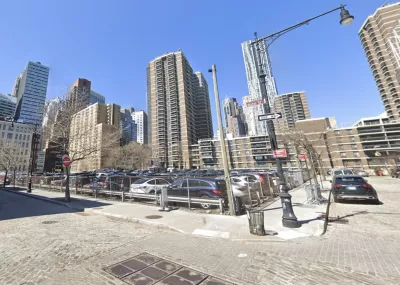A judge ruled against a decision by the Landmarks Preservation Commission to approve a 324-tower in the South Street Seaport Historic District, highlighting the tensions in a city facing a dearth of affordable housing.

A lot currently being used for parking in Manhattan’s South Street Seaport Historic District could be transformed into hundreds of units of housing—that is, if the parking lot wasn’t historically landmarked.
As Ginia Bellafante explains in The New York Times, when a developer proposed a 26-story building for the site at 250 Water Street, preservationist groups voiced their objections and sued, arguing that the building didn’t fit with the character of the historic district, could cause disruptions to a nearby school, and that the Landmarks Preservation Commission acted out of political interest when it approved the plan. “The proposal for the Water Street site includes 270 rental apartments, at least 70 of which would remain affordable, significantly, to those making an average of 40 percent of the area’s median income.” This means dozens of very low-income families “would qualify to live in a new building downtown, close to every conceivable means of public transportation and highly regarded public schools including Peck Slip, across the street.”
The preservationists won.
Bellafante calls this a “a particularly confounding example of the challenge to economically integrate wealthy neighborhoods in New York,” where community groups have obstructed the construction of new housing. With roughly 67,000 people sleeping in New York’s homeless shelters last November, Bellafante wonders, how does the aesthetic cohesiveness and ‘historic character’ of a neighborhood stack up against a desperate need for housing?
FULL STORY: In Affordable Housing v. Parking Lot, a Judge Chooses the Lot

Planetizen Federal Action Tracker
A weekly monitor of how Trump’s orders and actions are impacting planners and planning in America.

Maui's Vacation Rental Debate Turns Ugly
Verbal attacks, misinformation campaigns and fistfights plague a high-stakes debate to convert thousands of vacation rentals into long-term housing.

San Francisco Suspends Traffic Calming Amidst Record Deaths
Citing “a challenging fiscal landscape,” the city will cease the program on the heels of 42 traffic deaths, including 24 pedestrians.

Amtrak Rolls Out New Orleans to Alabama “Mardi Gras” Train
The new service will operate morning and evening departures between Mobile and New Orleans.

The Subversive Car-Free Guide to Trump's Great American Road Trip
Car-free ways to access Chicagoland’s best tourist attractions.

San Antonio and Austin are Fusing Into one Massive Megaregion
The region spanning the two central Texas cities is growing fast, posing challenges for local infrastructure and water supplies.
Urban Design for Planners 1: Software Tools
This six-course series explores essential urban design concepts using open source software and equips planners with the tools they need to participate fully in the urban design process.
Planning for Universal Design
Learn the tools for implementing Universal Design in planning regulations.
Heyer Gruel & Associates PA
JM Goldson LLC
Custer County Colorado
City of Camden Redevelopment Agency
City of Astoria
Transportation Research & Education Center (TREC) at Portland State University
Jefferson Parish Government
Camden Redevelopment Agency
City of Claremont





























